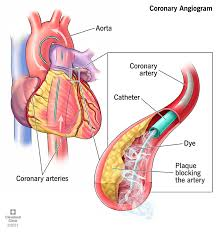The nurse is caring for a client following a cardiac angiogram (catheterization). It would be most important for the nurse to assess the client for:
Bleeding at the arterial puncture site.
Cardiac dysrhythmias related to catheter insertion.
Electrolyte imbalances related to dye injection.
Discomfort at the catheter insertion site.
The Correct Answer is A
Choice a reason:
Bleeding at the arterial puncture site is a primary concern post-cardiac angiogram, as it can lead to significant blood loss and hematoma formation. The nurse must frequently monitor the site for any signs of bleeding or hematoma, apply pressure if necessary, and report any abnormalities to the physician immediately.
Choice b reason:
Cardiac dysrhythmias may occur due to irritation of the heart muscle by the catheter during insertion. Monitoring the client's heart rhythm is essential to detect any new onset of arrhythmias, which could indicate complications from the procedure.
Choice c reason:
Electrolyte imbalances can result from the contrast dye used during a cardiac angiogram. The dye can affect kidney function, leading to changes in electrolyte levels. Monitoring electrolyte levels is important to prevent complications such as arrhythmias or fluid imbalances.
Choice d reason:
While discomfort at the catheter insertion site is expected, it is typically mild. However, the nurse should assess for discomfort as it may indicate other issues such as infection, bleeding, or a reaction to the procedure.
Nursing Test Bank
Naxlex Comprehensive Predictor Exams
Related Questions
Correct Answer is D
Explanation
Choice A Reason
Performing a bladder scan can help determine the volume of urine in the bladder and assess for urinary retention, which could contribute to bladder spasms. However, this is not typically the first intervention. The priority is to ensure that the catheter is patent and draining correctly, as blockages can cause immediate discomfort and increased spasms
Choice B Reason
Stopping the irrigation could be considered if there is a concern that the CBI is contributing to the spasms. However, this would not be the first action taken. It is essential first to assess the catheter's patency and the flow of the irrigation to rule out any obstruction or kinking causing the spasms.
Choice C Reason
Administering an oral analgesic may help alleviate the discomfort caused by bladder spasms, but it does not address the underlying cause. Pain relief is important, but the initial step should be to check for and resolve any mechanical issues with the catheter system that could be causing the spasms.
Choice D Reason
Ensuring that the catheter is draining properly is the first and most crucial intervention. If the catheter is blocked or kinked, it can cause bladder distention and increased spasms. Checking the catheter's patency and the flow of irrigation can quickly resolve the issue and provide relief to the patient. If the catheter is found to be obstructed, resolving the blockage can decrease the severity of the spasms and improve the patient's comfort.
Correct Answer is A
Explanation
Choice a reason:
A history of allergy to iodine is a critical finding to report before a coronary angiography because the contrast dye used in the procedure typically contains iodine. Patients with an iodine allergy may experience severe reactions, including anaphylaxis, which can be life-threatening. Precautions such as premedication with steroids and antihistamines or the use of alternative contrast agents may be necessary.
Choice b reason:
A serum potassium level of 4.0 mEq/L is within the normal range, which is approximately 3.5 to 5.2 mEq/L for adults. Therefore, this finding is not significant and does not need to be reported to the healthcare provider prior to the procedure.
Choice c reason:
A blood pressure reading of 138/90 mmHg is slightly elevated but does not reach the threshold for stage 1 hypertension, which starts at 140/90 mmHg for individuals under 60 years of age. While it should be monitored, it is not an urgent concern that needs to be reported immediately before a coronary angiography unless the patient shows symptoms of hypertensive crisis.
Choice d reason:
An EKG showing atrial fibrillation is an important finding; however, it is not typically a contraindication for coronary angiography unless the patient is hemodynamically unstable or symptomatic. Atrial fibrillation can increase the risk of stroke, but anticoagulation management is usually the focus rather than postponing necessary diagnostic procedures.

Whether you are a student looking to ace your exams or a practicing nurse seeking to enhance your expertise , our nursing education contents will empower you with the confidence and competence to make a difference in the lives of patients and become a respected leader in the healthcare field.
Visit Naxlex, invest in your future and unlock endless possibilities with our unparalleled nursing education contents today
Report Wrong Answer on the Current Question
Do you disagree with the answer? If yes, what is your expected answer? Explain.
Kindly be descriptive with the issue you are facing.
